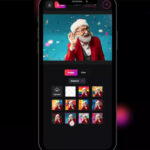Live Photos have become a captivating way to capture moments, adding a touch of motion to still images. If you’re an iPhone user, you’ve likely encountered this feature, which essentially animates a few seconds around your photos. But how do you share these dynamic shots on Instagram, a platform primarily designed for static images and videos? This guide will walk you through everything you need to know about uploading Live Photos to Instagram, ensuring your moving memories get the attention they deserve.
Understanding Live Photos and Instagram
Before diving into the “how-to,” let’s briefly understand what Live Photos are and why they resonate with Instagram’s current trends. Live Photos, available on iPhones 6s and later, are not quite videos and not just photos. They are 12-megapixel images that capture 1.5 seconds of motion before and after you press the shutter. This creates a short, animated clip when you press and hold the photo.
Instagram, once a haven for perfectly curated and often unrealistic imagery, is shifting towards authenticity. Users are increasingly craving genuine, behind-the-scenes content. This is where Live Photos shine. They offer a glimpse beyond the posed perfection, revealing the moments just before and after the “perfect shot.” For brands and individuals alike, Live Photos can foster a more personal and engaging connection with their audience by showcasing a more human and relatable side.
Quick Guide: Posting Live Photos to Instagram Stories
The most straightforward way to share your Live Photos on Instagram is through Stories. Instagram Stories are designed for ephemeral, in-the-moment content, making them a perfect fit for the spontaneous nature of Live Photos. However, there’s a small catch: you can only directly upload Live Photos taken within the last 24 hours to your Story.
Here’s how to post a recent Live Photo to your Instagram Story:
-
Open Instagram and Access Stories: Launch the Instagram app and tap the camera icon, usually located in the top left corner, to open the Stories interface.
-
Select Your Live Photo: Swipe up or tap on the photo gallery icon at the bottom left to access your camera roll. Choose the Live Photo you want to upload. Ensure it was taken within the last 24 hours to appear in the recent section.
-
Convert to Boomerang: Once you’ve selected your Live Photo, press and hold firmly on the screen. Instagram will automatically convert your Live Photo into a Boomerang. You’ll see the Boomerang symbol appear, indicating the conversion is successful.
-
Customize and Share: You can now add stickers, text, drawings, or filters to your Boomerang just like any other Story. Once you’re happy with your creation, tap “Your Story” to share it with your followers.
Step-by-Step: Uploading Live Photos to Your Instagram Feed
Posting Live Photos to your Instagram feed requires a few extra steps because Instagram feed posts are designed for longer-lasting content and have different format requirements than Stories. Since Live Photos are only 1.5 seconds long, and Instagram feed videos need to be at least 3 seconds, direct upload isn’t possible. However, there are effective workarounds to get your Live Photos onto your feed.
Here are three popular methods:
Method 1: Boomerang Conversion for Feed Posts
This method leverages Instagram’s built-in Boomerang feature, similar to how you post to Stories, but with a slight modification to save it for your feed.
- Access Instagram Stories: Tap the camera icon in the top left corner of your Instagram home screen to open the Stories interface.
- Choose Your Live Photo: Select your Live Photo from your camera roll (again, recent photos are easiest to access, but this method works even for older Live Photos).
- Convert to Boomerang: Press and hold firmly in the middle of the screen until the white circle and “Boomerang” text appear, indicating the Live Photo has been converted.
- Save the Boomerang: Instead of sharing to your Story, tap the “Save” button (downward arrow icon) usually located at the bottom of the screen. This saves the Boomerang as a video to your camera roll.
- Create a New Feed Post: Go back to your Instagram home page and tap the “+” icon at the bottom center to create a new post.
- Select the Boomerang Video: Choose the Boomerang video you just saved from your camera roll. It will now appear as a 6-second video, ready to be posted to your feed. Add a caption, hashtags, and location as usual, and share!
Method 2: Loop or Bounce via Photos App
For a slightly different effect and for Live Photos taken longer than 24 hours ago, you can use the “Loop” or “Bounce” effects directly within your iPhone’s Photos app before uploading to Instagram. These effects extend the duration of your Live Photo, making it suitable for feed posts.
- Open the Photos App: Exit Instagram and open the Photos app on your iPhone.
- Find Your Live Photo: Locate the Live Photo you want to post. This method works for both recent and older Live Photos.
- Swipe Up for Effects: Tap on the Live Photo to view it in full screen. Then, swipe up from the bottom of the screen to reveal the “Effects” menu. You’ll see options like “Live,” “Loop,” “Bounce,” and “Long Exposure.”
- Choose “Loop” or “Bounce”: Select either the “Loop” or “Bounce” effect. “Loop” will play your Live Photo continuously in a repeating loop, while “Bounce” plays it forward and then reverses it. Both options will create a video longer than 3 seconds.
 iPhone Photos app effects screen showing 'Loop' and 'Bounce' options for Live Photos, guiding users on how to loop or bounce live photos.
iPhone Photos app effects screen showing 'Loop' and 'Bounce' options for Live Photos, guiding users on how to loop or bounce live photos.
- Save and Upload to Instagram: The Photos app automatically saves the looped or bounced Live Photo as a video in your camera roll. Now, open Instagram, create a new feed post, and select this video from your library. Edit, add a caption, and share as you normally would.
Method 3: GIF Conversion using Apps
Another creative approach is to convert your Live Photo into a GIF. GIFs are widely supported on Instagram and offer a fun, looping animation style. Several third-party apps can help you easily convert Live Photos to GIFs. Popular choices include Motion Stills (by Google), Lively, and Alive.
- Download a GIF Converter App: Install a Live Photo to GIF converter app from the App Store (e.g., Motion Stills, Lively, or Alive).
- Convert Your Live Photo to GIF: Open the app and follow its instructions to import your Live Photo and convert it into a GIF. These apps usually offer customization options like loop style and speed.
- Save the GIF to Your Camera Roll: Once converted, save the GIF to your phone’s camera roll.
- Upload to Instagram: Open Instagram, create a new feed post, and select the GIF from your camera roll. Instagram treats GIFs like videos, so you can upload them to your feed just like any other video post.
Liven Up Your Instagram Presence with Live Photos
While directly uploading Live Photos to the Instagram feed isn’t yet a feature, these workarounds make it easy to share your moving moments. Whether you choose the Boomerang effect, looping/bouncing within the Photos app, or GIF conversion, Live Photos offer a fantastic way to add authenticity and engagement to your Instagram content. Embrace these techniques to make your feed more dynamic, connect with your audience on a deeper level, and stand out in the visually-driven world of Instagram.

